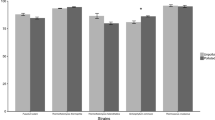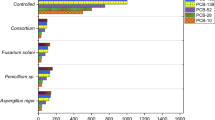Abstract
Pentachlorophenol (PCP) bioremediation by the fungal strains amongst the cork-colonising community has not yet been analysed. In this paper, the co- and direct metabolism of PCP by each of the 17 fungal species selected from this community were studied. Using hierarchical data analysis, the isolates were ranked by their PCP bioremediation potential. Fifteen isolates were able to degrade PCP under co-metabolic conditions, and surprisingly Chrysonilia sitophila, Trichoderma longibrachiatum, Mucor plumbeus, Penicillium janczewskii and P. glandicola were able to directly metabolise PCP, leading to its complete depletion from media. PCP degradation intermediates are preliminarily discussed. Data emphasise the significance of these fungi to have an interesting potential to be used in PCP bioremediation processes.



Similar content being viewed by others
Abbreviations
- PCP:
-
Pentachlorophenol
- HQ:
-
Hydroquinone
- CHQ:
-
Chlorohydroquinone
- TeCHQ:
-
Tetrachlorohydroquinone
- DCBQ:
-
2,6-Dichloro-1,4-benzoquinone
- TeCBQ:
-
Tetrachloro-1,4-benzoquinone
- PCA:
-
Pentachloroanisole
References
Alvarez-Rodriguez ML, Lopez-Ocana L, Lopez-Coronado JM, Rodriguez E, Martinez MJ, Larriba G, Coque JJR (2002) Cork taint of wines: role of the filamentous fungi isolated from cork in the formation of 2,4,6-trichloroanisole by O-methylation of 2,4,6-trichlorophenol. Appl Environ Microbiol 68(12):5860–5869
Basílio MC, Gaspar R, Silva Pereira C, San Romão MV (2006) Penicillium glabrum cork colonising isolates—preliminary analysis of their genomic similarity. Rev Iberoam Micol 23(3):151–154
Borazjani H, Ferguson B, Hendrix F, McFarland L, McGinnis G, Pope D, Strobel D, Wagner J (1989) Cladosporium sp., a potential fungus for bioremediation of wood-treating wastes. Abs Papers Am Chem Soc 197:80-ENVR
Carlile M, Watkinson S, Gooday G (2001) The fungi. Elsevier Academic Press, Amsterdam, p 588
Cserjesi AJ (1967) Adaptation of fungi to pentachlorophenol and its biodegradation. Can J Microbiol 13(9):1243–1245
Cserjesi AJ, Johnson EL (1972) Methylation of pentachlorophenol by Trichoderma virgatum. Can J Microbiol 18(1):45–47
Czaplicka M (2004) Sources and transformations of chlorophenols in the natural environment. Sci Total Environ 322(1–3):21–39
Danesh P, Velez Caldas F, Figueiredo Marques J, San Romao M (1997) Mycobiota in Portuguese ‘normal’ and ‘green’ cork throughout the manufacturing process of stoppers. J Appl Microbiol 82(6):689–694
Fahr K, Wetzstein HG, Grey R, Schlosser D (1999) Degradation of 2,4-dichlorophenol and pentachlorophenol by two brown rot fungi. FEMS Microbiol Lett 175(1):127–132
Johnson ME, Szekely A, Warnock DW (1998) In vitro activity of voriconazole, itraconazole and amphotericin B against filamentous fungi. J Antimicrob Chemother 42:741–745
Lacey J (1973) The air spora of a Portuguese cork factory. Ann Occup Hyg 16(3):223–230
Lamar RT, Larsen MJ, Kirk TK (1990) Sensitivity to and degradation of pentachlorophenol by Phanerochaete spp. Appl Environ Microbiol 56(11):3519–3526
Lyytikäinen M, Sormunen A, Peräniemi S, Kukkonen J (2001) Environmental fate and bioavailabilty of wood preservatives in freshwater sediments near an old sawmill site. Chemosphere 44(3):341–350
Maggi L, Mazzoleni V, Fumi MD, Salinas MR (2008) Transformation ability of fungi isolated from cork and grape to produce 2,4,6-trichloroanisole from 2,4,6-trichlorophenol. Food Addit Contam 25(3):265–269
McLellan L, Carvalho M, Silva Pereira C, Hursthouse A, Morrison C, Tatner P, Martins I, Romão MVS, Leitão M (2007) The environmental behaviour of polychlorinated phenols and its relevance to cork forest ecosystems: a review. J Environ Monitor 9:1055–1063
Mileski GJ, Bumpus JA, Jurek MA, Aust SD (1988) Biodegradation of pentachlorophenol by the white rot fungus Phanerochaete chrysosporium. Appl Environ Microbiol 54(12):2885–2889
Oliveira AC, Peres CM, Correia Pires JM, Silva Pereira C, Vitorino S, Figueiredo Marques JJ, Barreto Crespo MT, San Romao MV (2003) Cork stoppers industry: defining appropriate mould colonization. Microbiol Res 158(2):117–124
Prak S, Gunata Z, Guiraud JP, Schorr-Galindo S (2007) Fungal strains isolated from cork stoppers and the formation of 2,4,6-trichloroanisole involved in the cork taint of wine. Food Microbiol 24:271–280
Rabinovich ML, Bolobova AV, Vasil’chenko LG (2004) Fungal decomposition of natural aromatic structures and xenobiotics: a review. Appl Biochem Microbiol 40(1):1–17
Reddy GVB, Gold MH (2000) Degradation of pentachlorophenol by Phanerochaete chrysosporium: intermediates and reactions involved. Microbiology 146:405–413
Reddy GVB, Gelpke MDS, Gold MH (1998) Degradation of 2,4,6-trichlorophenol by Phanerochaete chrysosporium: involvement of reductive dechlorination. J Bacteriol 180(19):5159–5164
Seigle-Murandi F, Guiraud P, Steiman R, Benoitguyod JL (1992) Phenoloxidase production and vanillic acid metabolism by Zygomycetes. Microbiologica 15(2):157–165
Seigle-Murandi F, Steiman R, Benoitguyod JL, Guiraud P (1993) Fungal degradation of pentachlorophenol by micromycetes. J Biotechnol 30(1):27–35
Seigle-Murandi F, Toe A, Benoitguyod JL, Steiman R, Kadri M (1995) Depletion of pentachlorophenol by Deuteromycetes isolated from soil. Chemosphere 31(2):2677–2686
Semple KT, Reid BJ, Fermor TR (2001) Impact of composting strategies on the treatment of soils contaminated with organic pollutants. Environ Pollut 26:9–283
Serra R, Peterson S, Venancio A (2008) Multilocus sequence identification of Penicillium species in cork bark during plank preparation for the manufacture of stoppers. Res Microbiol 159(3):178–186
Silva Pereira C, Marques JJF, San Romão MV (2000) Cork taint in wine: scientific knowledge and public perception—a critical review. Crit Rev Microbiol 26(3):147–162
Silva Pereira C, Pires A, Valle MJ, Vilas-Boas L, Figueiredo Marques JJ, San Romão MV (2000) Role of Chrysonilia sitophila on the quality for cork stoppers for sealing wine bottle. J Ind Microbiol Biotech 24:256–261
Silva Pereira C, Soares GAM, Oliveira AC, Rosa ME, Pereira H, Moreno N, Romão MVS (2006) Effect of fungal colonization on mechanical performance of cork. Int Biodeter Biodegr 57(4):244–250
Soares GAM, Basílio MC, Tenreiro R, San Romão MV (2003) Diversity of Penicillium spp. colonising cork slabs: a classical and molecular approach. In: Lima N, Smith D (eds) Biological resource centres and the use of microbes. Micoteca da Universidade do Minho, Braga, pp 161–170
Solyanikova IP, Golovleva LA (2004) Bacterial degradation of chlorophenols: pathways, biochemical and genetic aspects. J Environ Sci Health Part B 39(3):333–351
Szewczyk R, Bernat P, Milczarek K, Dlugonski J (2003) Application of microscopic fungi isolated from polluted industrial areas for polycyclic aromatic hydrocarbons and pentachlorophenol reduction. Biodegradation 14(1):1–8
Taylor TR, Tucker T, Whalen MM (2005) Persistent inhibition of human natural killer cell function by ziram and pentachlorophenol. Environ Toxicol 20(4):418–424
Tomasini A, Flores V, Cortes D, Barrios-Gonzalez J (2001) An isolate of Rhizopus nigricans capable of tolerating and removing pentachlorophenol. World J Microbiol Biotechnol 17(2):201–205
Tortella GR, Diez MC, Duran N (2005) Fungal diversity and use in decomposition of environmental pollutants. Crit Rev Microbiol 31(4):197–212
van Leeuwen JA, Nicholson BC, Hayes KP, Mulcahy DE (1997) Degradation of chlorophenolic compounds by Trichoderma harzianum isolated from Lake Bonney, South-Eastern South Australia. Environ Toxicol Water Qual 12(4):335–342
Wong AS, Crosby DG (1981) Photo-decomposition of pentachlorophenol in water. J Agric Food Chem 29(1):125–130
Acknowledgments
MBC is grateful to FC&T for the fellowship SFRH/BD/18205/2004. The work was partially supported by FC&T (POCTI/AMB/57374/2004 and POCTI/QUI/56229/2004) and by NATO (ESP.MD.SFPP 981674). The authors wish to acknowledge M. Carmo Basílio and Dr. M. Vitória San Romão for providing the fungal strains used in this study.
Author information
Authors and Affiliations
Corresponding author
Additional information
M. B. Carvalho and I. Martins have contributed equally to this work.
Rights and permissions
About this article
Cite this article
Carvalho, M.B., Martins, I., Leitão, M.C. et al. Screening pentachlorophenol degradation ability by environmental fungal strains belonging to the phyla Ascomycota and Zygomycota. J Ind Microbiol Biotechnol 36, 1249–1256 (2009). https://doi.org/10.1007/s10295-009-0603-2
Received:
Accepted:
Published:
Issue Date:
DOI: https://doi.org/10.1007/s10295-009-0603-2




